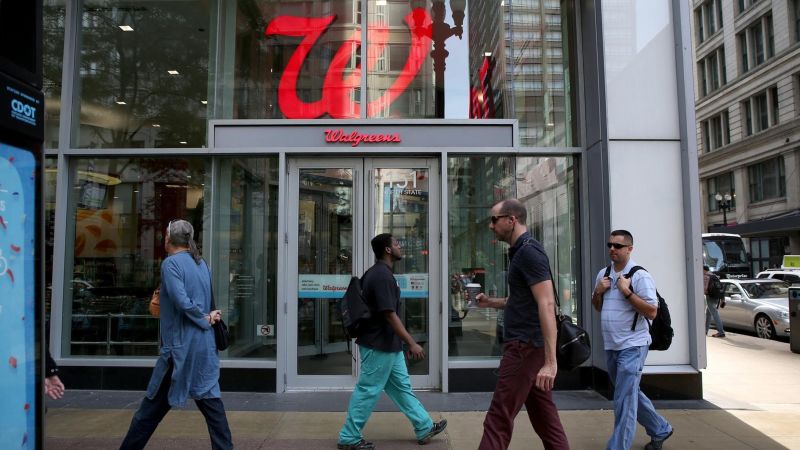Pharmacy staff at some Walgreens stores across the country say they will lock their gates and walk out Monday, citing harsh working conditions that make it difficult to safely fill prescriptions.
Pharmacists, technicians and support staff are planning walkouts from Monday through Wednesday, an organizer who asked to remain anonymous out of fear of retribution, confirmed to CNN.
Here’s what you need to know.
The number of staff who will walk off the job is unclear.
Unlike the WGA and United Auto Worker strikes, there is no union leader to coordinate and publicly address the movement. Instead, pharmacy employees are using platforms like Reddit and Facebook, as well as email and fliers, to plan walkouts.
Without a central organizing body, it is also difficult to confirm how many pharmacies will be closed. Organizers told CNN they had heard from well over 500 interested stores (out of approximately 9,000) across the country.
One employee planning to walk out told CNN that their pharmacy would shut down on Monday but that one staff member would remain to explain the closure to customers.
Another organizer told CNN that Walgreens had asked regional leaders to mobilize and staff the pharmacies on Monday.
Pharmacy staff are burned out.
A survey conducted last year by the American Pharmacists Association and the National Alliance of State Pharmacy Associations, found that pharmacy staff are inundated with demands for prescriptions, shots and other services without sufficient – or sufficiently trained – staff to fulfill the orders. Meanwhile, they complain that they face harassment and bullying by some patients.
The survey also found that pharmacy workers gripe about management’s focus on profit, facing constant disruptions to their workflow that prevent them from making decisions about how appropriate a treatment might be for a particular patient.
And when pharmacy workers take their complaints to management, they’ve fallen on deaf ears, the survey found.
“There is no open mechanism for pharmacists and pharmacy personnel to discuss workplace issues with supervisors and management; if they try, the discussion is not welcomed or heard,” the groups wrote.
Some CVS and Walgreens employees told CNN that a new focus on vaccinations added to their workload and made it more difficult to focus on filling prescriptions or customer care.
“It’s a hard job on a good day. It’s an incredibly rewarding job, but it’s hard,” said Amanda Applegate, the interim executive director of the Kansas Pharmacists Association. “And so the idea of pharmacists essentially being turned into ATMs in these environments, encouraging volume over quality, is why this is happening.”
Pharmacy employees are essential healthcare workers
Wolters Kluwer’s Pharmacy Next survey found that 58% of Americans are likely to first seek non-emergency healthcare at pharmacies. More than 80% said they trust a pharmacist, nurse, or nurse practitioner to diagnose minor illnesses and prescribe medications to treat them.
“Pharmacies are becoming a front-line site for non-emergency care, particularly among younger generations,” said Dr. Peter Bonis, the chief medical officer at Wolters Kluwer Health.
CVS recently had a walkout and talks are not over.
In September, CVS pharmacists in the Kansas City area closed as many as 22 pharmacies in two walkouts over two weeks in a planned protest, prompting executives to meet with staff and assure them that additional support and higher overtime pay were coming.
“Pharmacists are doing exactly what they’ve been trained to do, which is evaluate the situation and take whatever action is necessary to ensure that they’re providing the best patient care,” said Michael Hogue, CEO of the American Pharmacists Association, who traveled to Kansas City to meet with CVS executives and walkout organizers last week. “We have a widespread problem in the United States of inadequate staffing in community-based pharmacies.”
In an internal memo reviewed by CNN, Prem Shah, CVS’s chief pharmacy officer and president of pharmacy and consumer wellness, apologized to his Kansas City-based pharmacy teams for failing to address their concerns in a more timely manner.
Another meeting with Shah is planned for late this week, but no time or location has been set, a CVS walkout organizer told CNN.
CVS representatives told CNN that no specific talks have been scheduled because executives don’t see this as a “one-time meeting or update … it’s a continuous two-way dialogue to share how we’re meeting the commitments we made to our teams and to continue to hear their direct feedback,” said Amy Thibault, lead director of external communications for CVS Pharmacy.
A lead organizer of the CVS walkouts in Kansas City told CNN that if there is no meeting this week there could be another round of labor action.
Walgreens and CVS say they’re working with pharmacy staff to fix the situation.
In a statement to CNN, Walgreens acknowledged that pharmacy employees are overworked.
“The last few years have required an unprecedented effort from our team members, and we share their pride in this work — while recognizing it has been a very challenging time,” said Fraser Engerman, a spokesman for Walgreens. “We also understand the immense pressures felt across the US in retail pharmacy right now. We are engaged and listening to the concerns raised by some of our team members.”
Walgreens is “committed to ensuring that our entire pharmacy team has the support and resources necessary to continue to provide the best care to our patients while taking care of their own well-being,” added Engerman. “We are making significant investments in pharmacist wages and hiring bonuses to attract/retain talent in harder to staff locations.”
Similarly, CVS told CNN that the company is “committed to providing access to consistent, safe, high-quality health care to the patients and communities we serve and are working with our pharmacists to directly address any concerns they may have.”
The company is “focused on developing a sustainable, scalable action plan that can be put in place in markets where support may be needed so we can continue delivering the high-quality care our patients depend on,” a representative said.
Read the full article here









Leave a Reply